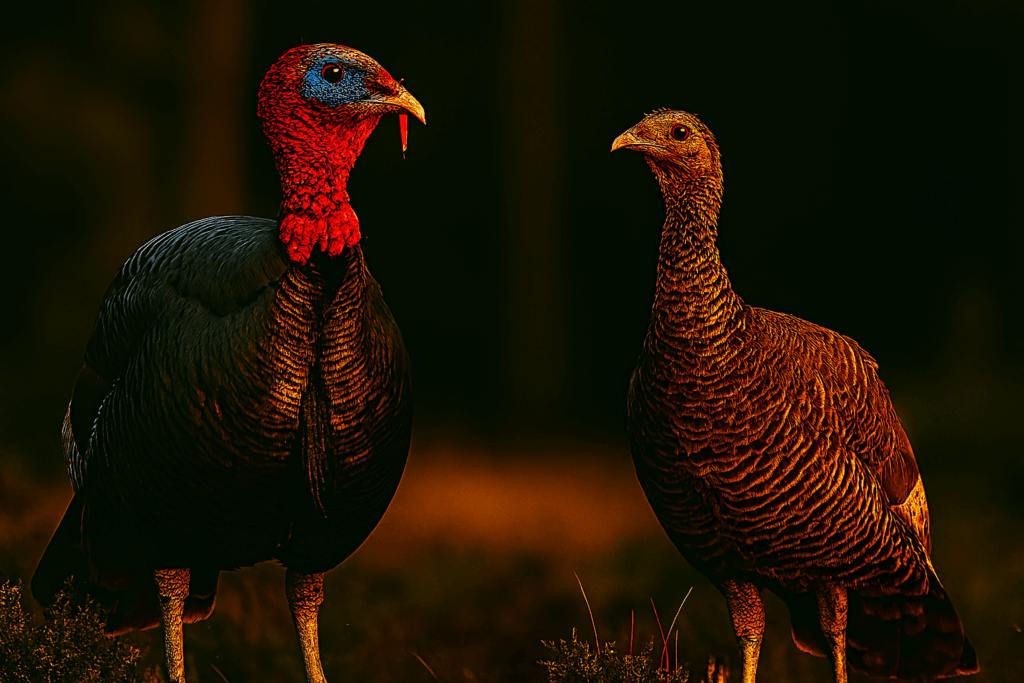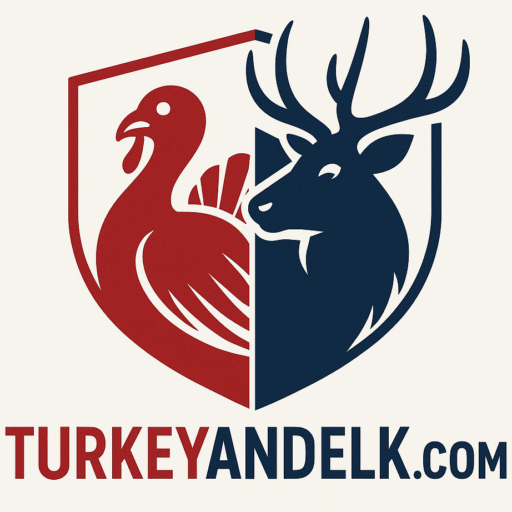Rio Grande Wild Turkey Hunting Tips
The Rio Grande wild turkey is the quintessential “everyone’s first turkey” subspecies—vocal, responsive, and found across vast swaths of the Great Plains. These medium-sized birds offer some of the most accessible and forgiving turkey hunting experiences in North America, making them ideal for new hunters seeking to learn the craft. However, don’t mistake their approachability for simplicity: success still requires understanding their unique biology, habitat preferences, and behavior patterns.

Biology and Physical Characteristics
Rio Grande gobblers average 20–22 pounds and stand about 36–40 inches tall, with hens weighing 10–12 pounds and measuring around 30 inches in height. Their most distinguishing feature is the uniformly tan or buff-colored tips on their tail feathers—unlike the chestnut tips of Easterns or the white tips of Merriam’s, Rio Grande tail fans glow golden in the morning light. Their body feathers range from bronze to copper, interspersed with vibrant green iridescence that shimmers when the sun hits at the right angle.
The wing pattern on Rios includes well-defined white and black bars, but the overall wing appearance is lighter than Eastern turkeys due to the pale tail tips and lighter breast feathers. Gobblers develop beards averaging 8–10 inches, and spurs reach 1–2 inches in mature toms, though spur length can vary depending on nutrition and genetics. Rio Grande gobbles have a distinctive yodel-like quality—sharper and higher-pitched than the rolling Eastern gobble—allowing hunters to pick them out by ear even at a distance.
Juvenile jakes typically have shorter, thinner beards (3–5 inches) and small rounded spurs, signaling their youth and relative challenge for hunters assessing trophy potential. Understanding these physical markers helps hunters determine a bird’s age class and adjust pursuit strategies accordingly.
Habitat and Geographic Range
Rio Grande turkeys thrive in semi-arid brushlands, riverbottoms, and agricultural mosaics across Texas, Oklahoma, and Kansas, with transplanted populations in Colorado, New Mexico, Arizona, and several western states. Their core range centers on the Great Plains, where mesquite, oak, juniper, and riparian corridors create the perfect blend of cover, food, and water.
Key habitat characteristics include:
- Scattered trees and brush for cover and roosting, often near water sources such as rivers, stock tanks, and spring-fed creeks.
- Agricultural fields and pasture edges that provide waste grains, seeds, and insect-rich foraging areas.
- Edge environments where grasslands meet brushy draws, offering both escape cover and feeding grounds.
Rio Grandes exhibit relatively small home ranges—typically 2,000–3,000 acres—thanks to the abundance of food in agricultural zones, contrasting sharply with the massive home ranges of mountain subspecies. Seasonal movements follow water availability: birds concentrate around permanent water during dry periods and expand into upland areas after rains replenish temporary ponds.
Elevation tolerance is broad; Rios occupy lowlands near sea level up to 5,000 feet in transitional zones, making them accessible to hunters across diverse landscapes. Their adaptability to varying climates and vegetation types contributes to their widespread distribution and makes them a reliable quarry for self-reliant hunters.
Behavior and Hunting Challenges
Rio Grande turkeys are renowned for their all-day vocality. Unlike Eastern turkeys that gobble heavily only during dawn and breeding peaks, Rio Grande gobblers call frequently from dawn to dusk, providing numerous opportunities to locate and engage birds. Their bold yodels echo across fields and draws, making them easier to pinpoint than more secretive subspecies.
However, their boldness comes with challenges:
- Henned-Up Behavior: During the breeding season, gobblers often gather harems of 3–6 hens, concentrating their attention on real hens rather than responding to lone hen calling. Hunters must out-call both gobblers and the competing clucks of actual hens.
- Lockdown Post-Gobble: After gobbling, Rios sometimes go silent and freeze in place, scanning for danger. Hunters may hear the initial gobble but struggle to elicit further calling if they over-call or spook birds with movement.
- Edge Ambush Awareness: Birds hunting field edges develop acute alertness to movement along cover lines. Hunters must minimize motion and maintain concealment to get within calling range.
Weather influences behavior markedly. High winds can muffle calls and reduce gobbling, while barometric pressure increases stimulate gobbling activity. Rios feed heavily on waste grain after harvest seasons, becoming less vocal when food is abundant and more vocal during lean periods when hen responses to calls intensify.
Hunting Strategies and Techniques
Effective Rio Grande hunting combines mobile tactics with strategic calling that leverages their vocal nature without over-calling.
- Run-and-Gun: Cover ground quickly during early morning, stopping every quarter-mile to call and locate responsive gobblers. Use loud locator calls—owl hoots or crow calls—to trigger distant gobbles, then close fast.
- Roost Hunts: Pre-season scouting to identify roost trees pays dividends. Approach roost areas before legal shooting time and set up along known travel routes 100–150 yards from roost, using soft yelps at first light to draw birds from the trees.
- Edge Setups: Position setups along fence lines, brushy draws, or roadside edges where birds regularly travel between feeding and cover. Use subtle clucks and purrs to lull birds into complacency before switching to gentle yelps to trigger gobblers.
- Decoy Usage: Hen and jake-hen pairs work best. Place decoys 15–20 yards out, slightly off to the side, to offer clear kill angles. Limited decoy spreads avoid spooking wary birds that have seen flashy setups near roads.
- Midday Calling Ambush: Rios gobble mid-morning as birds regroup after initial feedings. Set up near midday feeding zones when other hunters have quit, using soft calling to intercept lone gobblers separated from hen groups.
Concealment is critical: choose natural cover like live oak thickets or tall grass, and wear earth-toned camouflage that breaks up human outlines. Maintain absolute stillness during pinpoint calling periods to avoid alerting sharp-eyed birds.
Public Land Locations and Access
Rio Grande turkeys offer some of the best public-land turkey hunting opportunities in North America due to the vast network of state wildlife areas, national grasslands, and wildlife management areas (WMAs) across the Great Plains.
- Texas: With over 50 WMAs providing free or low-cost access, Texas is the Rio Grande capital. Areas like Matador, Eagle Mountain, and Kit McClure WMAs hold reliable turkey populations and offer generous public access.
- Oklahoma: Fort Reno Wildlife Management Area and Gloss Mountain WMA feature healthy Rio Grande populations and robust hunter infrastructure, including road access and trail systems.
- Kansas: The Kansas Wildlife Areas, particularly the Milford and Chem‐Northeast units, host expanding Rio Grande flocks in riparian corridors and river‐bottom woodlands.
- Colorado & New Mexico: Transplanted populations in eastern Colorado (Pawnee National Grassland) and northeastern New Mexico provide OTC tags and excellent public land hunts. Look for WMAs with nearby water sources and mixed brush/grass habitats.
Success on public land hinges on finding less-pressured areas more than a mile from parking zones, as 80% of hunters remain within 300 yards of access points. Use satellite imagery and public land maps to identify remote pockets of suitable habitat with water, brush, and field edges.
Hunt weekdays and avoid opening weekend crowds. Scout pre-season to reduce intrusions during the season. Many public WMAs allow nonresident tags OTC, making Rios ideal for self-reliant travelers seeking value.
Season Information and Regulations
Rio Grande turkey seasons generally run from late March through early May, with specific dates and bag limits varying by state and management unit.
- Texas: Spring season typically opens late April and runs five weeks; bag limit two gobblers per season, with one per day. Nonresidents pay modest tag fees and can hunt OTC.
- Oklahoma: Seasons vary by unit but generally run April 1–May 15 with a one-bird daily limit and two-bird season limit. Some WMAs require quota permits for prime weeks.
- Kansas: Spring hunt spans mid-April to mid-May; bag limit two birds per season, with youth seasons preceding regular seasons. Tags are OTC for residents and nonresidents.
- Colorado/New Mexico: Transplanted Rio Grande hunts occur alongside Merriam’s seasons; check unit-specific regulations. Bag limits one bearded bird per license, with over-the-counter tags in designated units.
- Weapon Restrictions: Generally allow shotguns (no larger than #4 shot), archery equipment, and muzzleloaders. Rifles prohibited during spring seasons. Hunting hours from one-half hour before sunrise to noon early in the season, expanding to sunset later in the season.
- Licenses and Reporting: All states require hunting licenses and turkey permits; youth seasons often require adult supervision. Harvest reporting within 24–72 hours via phone or online systems is mandatory.
Consult local wildlife agency regulations before hunting, as specific units may impose additional restrictions, permit draws, or check-in requirements.
Trophy Considerations and Record Keeping
Rio Grande turkeys are prized for their distinctive tail coloration and wide distribution, offering trophy opportunities that balance accessibility with genuine challenge.
- Beard Length: Mature toms average 8–10-inch beards. Exceptional birds exceeding 11 inches are prized but less common than Eastern record-book birds.
- Spur Size: Spurs reach 1–2 inches, with quality birds exhibiting thick, sharp dagger spurs. Spur measurement and wear patterns help estimate age classes.
- Weight: A spring gobbler over 22 pounds qualifies as a solid trophy; weights vary based on habitat quality and food availability.
- Scoring: Use NWTF guidelines combining beard length, spur length, and body weight. Rio Grande entries require a minimum combined score, typically around 65 points for record recognition.
- Care: Photograph birds immediately with measuring tape visible. Keep feathers dry and free of bloodstains. Follow standard field-care protocols for taxidermy and record submissions.
Rio Grande birds rarely match the extreme measurements of Eastern turkeys, but their broad range and responsive behavior make them ideal for trophy pursuers on a budget.
Conservation and Population Status
Rio Grande turkey populations recovered from historic lows of around 100,000 birds in the 1920s to over 7 million across North America today, thanks to widespread restoration programs and agricultural habitat expansion. Key conservation milestones include:
- Transplant Programs: Successful relocations to western states during the mid-20th century created new hunting opportunities and stabilized populations.
- Habitat Management: Partnership programs encourage landowners to maintain brushy fence lines, water sources, and nesting habitats, funded by hunter license dollars and conservation grants.
- Current Status: Populations in core states remain stable to increasing, though localized declines occur due to drought and habitat loss.
- Threats: Drought, wildfires, and agricultural land conversion pose ongoing challenges. Conservation efforts focus on water development projects, brush management, and maintaining public-land habitat quality.
- Research: Ongoing studies monitor gobbling patterns, movement ecology, and harvest impacts, guiding adaptive management and season length adjustments.
Hunters support conservation through license purchases and conservation organization memberships, ensuring the long-term viability of Rio Grande turkeys and their habitats.
Tips for First-Time Hunters
For novices pursuing Rio Grande turkeys, focus on fundamentals: call practice, scouting, and mobility.
- Master Basic Calls: Start with the yelp, cluck, and purr on a slate or box call. Rio Grandes respond readily to simple, realistic hen sounds. Avoid over-calling.
- Scout Early: Identify roost trees and travel corridors before season. Use trail cameras sparingly. Look for fresh tracks, droppings, and scratchings along field edges.
- Edge Ambush Tactics: Set up along fence lines or brushy draws adjoining fields. Position decoys 15–20 yards away to simulate feeding hens. Be ready for quick shots.
- Run-and-Gun Drills: Practice moving and calling fluidly. Hike 1–2 miles each hunt, stopping every few hundred yards to call and glass for responses.
- Hunt Midweek: Avoid weekend crowds. Public lands are less pressured on weekdays, improving response rates.
- Weather Awareness: Plan hunts around stable weather. Barometric pressure increases trigger gobbling; rain and high winds suppress it.
- Shot Prep: Practice from sitting and kneeling positions against natural rests. Rios often present shots in tight cover at 20–30 yards.
- Safety First: Identify targets positively. Wear fluorescent orange when relocating. Maintain situational awareness on public lands.
Embrace the vocal nature of Rio Grande turkeys and their predictable patterns. With solid calling skills, effective scouting, and a willingness to move, new hunters can enjoy consistent success and memorable first tags with the Great Plains gobbler.
